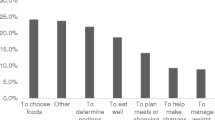Abstract
Background. The evidence of health benefits associated with the consumption of a variety fruits and vegetables (FV) is well known. The “5 A Day Color Way” campaign is a national effort to translate the science with a message of increased colorful FV consumption for the public. The extent of the translation and adherence to these recommendations among families in a community setting is an important public health question.Methods. Parents enrolled in 8 rural Missouri county parent education programs answered surveys for their preschool children (n=1658) about FV consumption and barriers to purchasing them by color.Results. Of parents, 40% (n=668) and 26% (n=425) of children ate from all 5 colors some time the previous week. However, no parents and only 1 child attained perfect adherence to the guidelines (all 5 colors most days of the week). Disliking the taste and not in the habit of purchasing colorful FV were significant predictors for not meeting recommendations for red, yellow/orange, and green FV.Conclusions. Interventions targeting young children and their families (ie, child care settings, elementary schools) that establish preference for color specific FV may be ideal in rural communities to encourage movement toward adherence to the campaign.
Similar content being viewed by others
References
Nanney M, Haire-Joshu D, Brownson R. Rationale for a “power-house” approach to vegetable and fruit interventions. Am J Diet. 2004;104:352–356.
Van Duyn MAS, Pivonka E. Overview of the health benefits of fruit and vegetable consumption for dietetics profesional: selected literature. J Am Diet Assoc. 2000;100:1511–1521.
Lui R. Health benefits of fruit and vegetables are from additive and synergistic combination of phytochmeicals. Am J Clin Nutr. 2003;73(suppl 3):517S-520S.
Heimendinger J, Van Duyn MA, Chapelski D, Foerster S, Stables G. The national 5 A Day for Better Health program: a large-scale nutrition intervention. J Public Health Manag Pract. 1996;2:27–35.
5 a Day the Color Way. Why 5 a Day the Color Way. 5 a Day Web site. Available at: http://www.5aday.com. Accessed October 16, 2006.
Center for Disease Control and Prevention. 5 a Day: Data and Statistics Display. 2005. Available at: www.apps.nccd.cdc.gov/ 5ADaySurveillance/displayV.asp. Accessed March 29, 2006.
2001 Annual Report. Parents as Teachers National Center, Inc. St. Louis, Missouri. Parents as Teachers Web site. Available at: http://www.parentsasteachers.org. Accessed October 16, 2006.
Brownson RC, Smith CA, Pratt M, et al. Preventing cardiovascular disease through community-based risk reduction: the Bootheel Heart Health Project. Am J Public Health. 1996;86:206–213.
Nanney M, Haire-Joshu D, Hessler K, Elliott M, Brownson R. Evaluating changeability to improve fruits and vegetables intake among school aged children. Nutr J. 2005;4:34.
Linneman C, Hessler K, Nanney S, Steger-May K, Haire-Joshu D. Parents are accurate reporters of their preschoolers’ fruit and vegetable consumption under limited conditions. J Nutr Educ Behav. 2004;36:305–308.
Nanney MS, Johnson S, Elliott M, Haire-Joshu D. Eating home grown produce is associated with higher intake and less costs for parents and their preschool children in rural Missouri. J Am Diet Assoc. In press.
Pomerleau J, Lock K, Knai C, McKee M. Interventions designed to increase adult fruit and vegetable intake can be effective: a systematic review of the literature. J Nutr. 2005;135:2486–2495.
Knai C, Pomerleau J, Lock K, McKee M. Getting children to eat more fruit and vegetables: a systematic review. J Prev Med. 2006;42:85–95.
Noakes M, Clifron P, Ntanios F, Shrapnel W, Record I. An increase in dietary carotenoids when consuming plant sterols or stanols is effective in maintaining plasma carotenoid concentrations. Am J Clin Nutr. 2002;75:79–86.
Lanza E, Schatzkin A, Daston C, Corle D, Freedman L. Implementation of a 4-y, high-fiber, high-fruit-and-vegetable, low-fat dietary intervention: results of dietary changes in the Polyp Prevention Trial. Am J Clin Nutr. 2001;74:387–401.
Rock CL, Moskowitz A, Huizar B, Saenz CC, Clark JT, Daly TL. High vegetable and fruit diet intervention in premenopausal women with cervical intraepithelial neoplasia. J Am Diet Assoc. 2001;101:1167–1174.
Smith-Warner S, Elmer P, Tharp T, et al. Increasing vegetable and fruit intake: randomized intervention and monitoring in an at-risk population. Cancer Epidemiol Biomarkers Prev, 2000;9:307–317.
Glanz K, Basil M, Maibach E, Goldberg J, Snyder D. Why Americans eat what they do: taste, nutrition, cost, convenience, and weight control concerns as influences on food consumption. J Am Diet Assoc. 1998;98:1118–1126.
Blanchette L, Brug J. Determinants of fruit and vegetable consumption among 6 12 year old children and effective interventions to increase consumption. J Hum Nutr Diet. 2005;18:431–443.
Cullen K, Baranowski T, Owens E, Marsh T, Rittenberry L, de Moor C. Availability, accessibility, and preferences for fruit, 100% fruit juice, and vegetable influence children’s dietary behaviors. Health Educ Behav. 2003;30:615–626.
Birch L. Development of food preferences. Annu Rev Nutr. 1999;19:41–62.
Birch L. What kind of exposure reduces children’s food neophobia? Looking vs tasting. Appetite. 1987;9:171–178.
Nicklas T, Johnson R. Dietary guidance for healthy children aged 2 to 11 years. J Am Diet Assoc. 2004;104:660–677.
Author information
Authors and Affiliations
Corresponding author
Additional information
Supported by the National Cancer Institute (5 R01 CA68398).
Rights and permissions
About this article
Cite this article
Nanney, M.S., Schermbeck, R. & Haire-Joshu, D. Examination of the adherence to the “5 a Day the Color Way” campaign among parents and their preschool children. J Canc Educ 22, 177–180 (2007). https://doi.org/10.1007/BF03174333
Issue Date:
DOI: https://doi.org/10.1007/BF03174333




